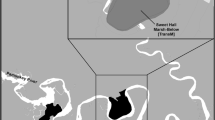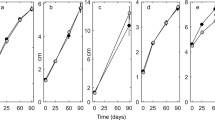Abstract
Herbivory is now recognized as an important structuring agent in seagrass meadows but the attack pattern and tissue damage of consumers are highly variable. Nutritional preferences of herbivores and/or easy access to resources may cause differences in biomass loss among tissues that damage the plant in functionally distinctive ways. The two main Mediterranean herbivores, the fish Sarpa salpa (L.) and the sea urchin Paracentrotus lividus (Lmk.), remove higher amounts of intermediate and external shoot leaves, respectively. To test whether this selective feeding can have different consequences on the allocation patterns of nutrient within plants, we simulated the effect of both herbivores by clipping external and intermediate leaves (plus unclipped controls) of Posidonia oceanica (L.) and we measured plant tolerance in terms of shoot growth and leaf nutrient supply to new tissue using isotopic markers. As expected, control treatments displayed high carbon and nutrient supply from external leaves (83% of the total 15N and 84% of the total 13C incorporated by the shoot). When subjected to clipping, the remaining leaves enhanced carbon and nitrogen supply compared with the control by 16% of N and 36% of C—in the intermediate clipping—and by over 100% of N and 200% of C—in the external clipping—to compensate for the nutrient lost. However, only in the case of fish herbivory (intermediate clipping), enhanced supply alone was able to fully compensate for the nutrient losses. In contrast, this mechanism is not completely effective when external leaves are clipped (urchin herbivory). Yet, the consequences of this nutrient loss under sea urchin herbivory are not apparent from the nutrient content of the new tissue, suggesting that there are other sources of nitrogen income (uptake or reallocation from rhizomes). Our study does not only confirm the tolerance of P. oceanica to herbivory, but also constitutes the first evidence of leaf-specific, compensatory nutrient supply in seagrasses.





Similar content being viewed by others
References
Alcoverro T, Mariani S (2002) Effects of sea urchin grazing on seagrass (Thalassodendron ciliatum) beds of a Keyan lagoon. Mar Ecol Prog Ser 226:255–263. doi:10.3354/meps226255
Alcoverro T, Manzanera M, Romero J (2000) Nutrient mass balance of the seagrass Posidonia oceanica: the importance of nutrient retranslocation. Mar Ecol Prog Ser 194:13–21. doi:10.3354/meps
Aragones L, Marsh H (2000) Impact of dugong grazing and turtle cropping on tropical seagrass communities. Pac Conserv Biol 5:277–288
Aragones LV, Lawler IR, Foley WJ, Marsh H (2006) Dugong grazing and turtle cropping: grazing optimization in tropical seagrass systems? Oecologia 149:635–647. doi:10.1007/s00442-006-0477-1
Avery DJ, Briggs JB (1968) The aetiology and development of damage in young fruit trees infested with fruit tree red spider mite, Panonychus ulmi (koch). Ann Appl Biol 61:277–288. doi:10.1111/j.1744-7348.1968.tb04532.x
Avery DJ, Lacey HJ (1968) Changes in the growth-regulator content of plum infested with fruit tree red spider mite, Panonychus ulmi (Koch). J Exp Bot 19:760–769. doi:10.1093/jxb/19.4.760
Bjorndal KA (1980) Nutrition and grazing behaviour of the green turtle, Chelonia mydas. Mar Biol 56:147–154. doi:10.1007/BF00397131
Borum J, Murray L, Kemp WM (1989) Aspects of nitrogen acquisition and conservation in eelgrass plants. Aquat Bot 35:289–300. doi:10.1016/0304-3770(89)90003-x
Caldwell MM, Richards JH, Johnson DA, Nowak RS, Dzurec RS (1981) Coping with herbivory: photosynthetic capacity and resource allocation in two semiarid Agropyron bunchgrasses. Oecologia 50:14–24. doi:10.1007/BF00378790
Cebrián J, Duarte CM, Marbà N, Enríquez S, Gallegos M, Olesen B (1996a) Herbivory on Posidonia oceanica: magnitude and variability in the Spanish Mediterranean. Mar Ecol Prog Ser 130:147–155. doi:10.3354/meps130147
Cebrián J, Duarte CM, Pascual J (1996b) Marine climate on the Costa Brava (northwest Mediterranean) littoral. Publ Espec Inst Esp Oceanogr 22:9–21
Chabot BF, Hicks DJ (1982) The ecology of leaf life spans. Ann Rev Ecol Syst 13:229–259. doi:10.1146/annurev.es.13.110182.001305
Crawley M (1989) The relative importance of vertebrate and invertebrate herbivores in plant population dynamics. In: Bernays EA (ed) Insect–plant interactions, vol 1. CRC Press, Boca Raton, pp 45–71
Crawley M (1997) Biodiversity. In: Crawley MJ (ed) Plant Ecology. Blackwell, Oxford, pp 595–632
De Muizon C, McDonald G, Salas R, Urbina M (2004) The evolution of feeding adaptations of the aquatic sloth Thalassocnus. J Vertebr Paleontol 24:398–410. doi:10.1671/2429b
Demment MW, Soest PJV (1985) A Nutritional explanation for body-size patterns of ruminant and nonruminant herbivores. Am Nat 125:641–672. doi:10.1086/284369
Detling JK, Dyer MI, Winn DT (1979) Net photosynthesis, regrowth of Bouteloua gracilis following simulated grazing. Oecologia 41:127–134. doi:10.1007/BF00344997
Domning DP (1981) Sea cows and sea grasses. Paleobiology 7:417–420
Fay PA, Hartnett DC, Knapp AK (1996) Plant tolerance of Gall-insect attack and Gall-insect performance. Ecology 77:521–534. doi:10.2307/2265627
Ferrari B, Raventos N, Planes S (2007) Assessing effects of fishing prohibition on Posidonia oceanica seagrass meadows in the marine natural reserve of Cerbère-Banyuls. Aquat Bot 88:295–302. doi:10.1016/j.aquabot.2007.12.002
Gonfiantini R, Stichler W, Rozanski K (1995) Standards and intercomparison materials distributed by the international atomic energy agency for stable isotope measurements. IAEA TEC-DOC 825:13–29
Harnett DC (1989) Density- and growth stage-dependent responses to defoliation in two rhizomatous grasses. Oecologia 80:414–420. doi:10.1007/BF00379045
Harrison PG (1978) Patterns of uptake and translocation of 14C by Zostera americana den Hartog in the laboratory. Aquat Bot 5:93–97. doi:10.1016/0304-3770(78)90050-5
Heck JL, Valentine JF (2006) Plant–herbivore interactions in seagrass meadows. J Exp Mar Biol Ecol 330:420–436. doi:10.1016/j.jembe.2005.12.044
Hemminga MA, Harrison PG, van Lent F (1991) The balance of nutrient losses and gains in seagrass meadows. Mar Ecol Prog Ser 71:85–96
Honkanen T, Jormalainen V (2002) Within-plant integration and compensation: effects of simulated herbivory on growth and reproduction of the brown alga, Fucus vesiculosus. Int J Plant Sci 163:815–823. doi:10.1086/342081
Honkanen T, Haukioja E, Kitunen V (1999) Responses of Pinus sylvestris branches to simulated herbivory are modified by tree sink/source dynamics and by external resources. Funct Ecol 13:126–140. doi:10.1046/j.1365-2435.1999.00296.x
Ivany LC, Portell RW, Jones DS (1990) Animal–plant relationships and paleobiogeography of an eocene seagrass community from Florida. Palaios 5:244–258. doi:0883-1351/90/0005-0244
Kotanen PM, Rosenthal JP (2000) Tolerating herbivory: does the plant care if the herbivore has a backbone? Evol Ecol 14:537–549. doi:10.1023/A:1010862201331
Lepoint G, Millet S, Dauby P, Gobert S, Bouquegneau J-M (2002) Annual nitrogen budget of the seagrass Posidonia oceanica as determined by in situ uptake experiments. Mar Ecol Prog Ser 237:87–96. doi:10.3354/meps237087
Libes M, Boudouresque CF (1987) Uptake and long-distance transport of carbon in the marine phanerogam Posidonia oceanica. Mar Ecol Prog Ser 38:177–186
Liu H-D, Yu F-H, He W-M, Chu Y, Dong M (2007) Are clonal plants more tolerant to grazing than co-occurring non-clonal plants in inland dunes? Ecol Res 22:502–506. doi:10.1007/s11284-007-0332-9
Lobel PS, Ogden JC (1981) Foraging by the herbivorous parrotfish Sparisorna radians. Mar Biol 64:173–183. doi:10.1007/BF00397106
Macià S, Robbinson MP (2005) Effects of habitat heterogeneity in seagrass beds on grazing patterns of parrotfishes. Mar Ecol Prog Ser 303:113–121. doi:10.3354/meps303113
Marbà N, Hemminga MA, Mateo MA, Duarte CM, Mass YE, Terrados J, Gacia E (2002) Carbon and nitrogen translocation between seagrass ramets. Mar Ecol Prog Ser 226:287–300. doi:10.3354/meps226287
Marquis R (1992) Selective impact of herbivores. In: Fritz RS, Simms EL (eds) Plant resistance to herbivores and pathogens: ecology, evolution, and genetics. The University of Chicago Press, Chicago, pp 301–325
McAfee ST, Morgan SG (1996) Resource use by five sympatric parrotfishes in the San Blas Archipelago, Panama. Mar Biol 125:427–437. doi:10.1007/BF00353255
Nakaoka M, Aioi K (1999) Growth of seagrass Halophila ovalis at dugong trails compared to existing within-patch variation in a Thailand intertidal flat. Mar Ecol Prog Ser 184:97–103. doi:10.3354/meps184097
Obeso JR (1993) Does defoliation affect reproductive output in herbaceous perennials and woody plants in different ways? Funct Ecol 7:150–155. doi:10.2307/2389881
Pedersen MF, Paling EI, Walker DI (1997) Nitrogen uptake and allocation in the seagrass Amphibolis antarctica. Aquat Bot 56:105–117. doi:10.1016/S0304-3770(96)01100-x
Pinna S, Pais A, Chessa L, Sechi N, Ceccherelli G (2009) Spatial variation of Paracentrotus lividus and Sarpa salpa herbivory on Posidonia oceanica seagrass meadows. Estuar Coast Shelf Sci 84:21–27. doi:10.1016/j.ecss.2009.05.025
Prado P, Tomas F, Alcoverro T, Romero J (2007) Extensive direct measurements of Posidonia oceanica defoliation confirm the importance of herbivory in temperate seagrass meadows. Mar Ecol Prog Ser 340:63–71. doi:10.3354/meps340063
Prado P, Farina S, Tomas F, Romero J, Alcoverro T (2008a) Marine protected areas and seagrass availability alter fish herbivory in seagrass ecosystems. Mar Ecol Prog Ser 371:11–21. doi:10.3354/meps07662
Prado P, Collier C, Lavery P (2008b) Within-shoot and among-shoot 13C and 15N translocation in two Posidonia species from Western Australia. Mar Ecol Prog Ser 361:69–82. doi:10.3354/meps07405
Prado P, Alcoverro T, Romero J (2010) Influence of nutrients in the feeding ecology of seagrass (Posidonia oceanica L.) consumers: a stable isotopes approach. Mar Biol 157(4):715–724. doi:10.1007/s00227-009-1355-2
Randall JE (1965) Grazing effect on seagrasses by herbivorous reef fishes in the West Indies. Ecology 46:255–260
Romero J (1989) Primary production of Posidonia oceanica beds in the Medas Islands (Girona, NE Spain). In: Boudouresque CF, Meinesz A, Fresi E, Gravez V (eds) International workshop on Posidonia oceanica beds, vol 2. GIS Posidonie Publications, France, pp 83–86
Romero J, Martinez-Crego B, Alcoverro T, Perez M (2007) A multivariate index based on the seagrass Posidonia oceanica (POMI) to assess ecological status of coastal waters under the water framework directive (WFD). Mar Pollut Bull 55:196–204. doi:10.1016/j.marpolbul.2006.08.032
Ryle GJA, Powell CE (1975) Defoliation and regrowth in the graminaceous plant: the role of current assimilate. Ann Bot (Lond) 39:297–310
Sand-Jensen K, Jacobsen D, Duarte CM (1994) Herbivory and resulting plant damage. Oikos 69:545–549
Shepherd A (1987) Grazing by the sea-urchin Paracentrotus lividus in Posidonia beds at Banyuls, France. In: Boudouresque CF (ed) Colloque International sur Paracentrotus lividus et les oursins comestibles. GIS Posidonie, Marseille, pp 83–86
Sosebee RE, Wiebe HH (1971) Effect of water stress and clipping on photosynthate translocation in two grasses. Agron J 63:14–19
Strong DR, Lawton JH, Southwood R (1984) Insects on plants: community patterns and mechanisms. Harvard University Press, Cambridge
Thayer GW, Bjorndal KA, Odgen JC, Williams SL, Zieman JC (1984) Role of larger herbivores in seagrass communities. Estuaries 7(4A):351–376
Tomas F, Turón X, Romero J (2005) Seasonal and small-scale spatial variability of herbivory pressure on the temperate seagrass Posidonia oceanica. Mar Ecol Prog Ser 301:95–107. doi:10.3354/meps301095
Touchette BW, Burkholder JM (2000) Review of nitrogen and phosphorus metabolism in seagrasses. J Exp Mar Biol Ecol 250:133–167. doi:10.1016/S0022-0981(00)00195-7
Uhen MD (2007) Evolution of marine mammals: back to the sea after 300 million years. Anat Rec 290:514–522. doi:10.1002/ar.20545
Unsworth RKF, Taylor JD, Powell A, Bell JJ, Smith DJ (2007) The contribution of scarid herbivory to seagrass ecosystem dynamics in the Indo-Pacific. Estuar Coast Shelf Sci 74:53–62. doi:10.1016/j.ecss.2007.04.001
Valentine JF, Blythe EF, Madhavan S, Sherman TD (2004) Effects of simulated herbivory on nitrogen enzyme levels, assimilation and allocation in Thalassia testudinum. Aquat Bot 79:235–255. doi:10.1016/j.aquabot.2004.04.001
Varnamkhasti AS, Milchunas DG, Lauenroth WK, Goetz HL (1995) Production and rain use efficiency in short-grass steppe: grazing history, defoliation and water resource. J Veg Sci 6:787–796. doi:10.2307/3236392
Vergés A, Pérez M, Alcoverro T, Romero J (2008) Compensation and resistance to herbivory in seagrasses: induced responses to simulated consumption by fish. Oecologia 155:751–760. doi:10.1007/s00442-007-0943-4
Zimmerman R, Steller DL, Kohrs DG, Alberte RS (2001) Top-down impact through a bottom-up mechanism. In situ effects of limpet grazing on growth, light requirements and survival of the seagrass Zostera marina. Mar Ecol Prog Ser 218:127–140. doi:10.1007/BF00333949
Acknowledgments
This work was supported by a FI scholarship from the Departament d’Universitats, Recerca i Societat de la Informació (DURSI, Generalitat de Catalunya) to P. Prado, and the CGL2007-66771-C02 and CGL2009-12562 grants from the Spanish Ministry of Science and Innovation. C. Collier was supported by a short-term outgoing scholarship from the Australian Strategic Research Fund for the Marine Environment and a travel grant from the Centre for Ecosystem Management, Edith Cowan University, Perth, Western Australia.
Author information
Authors and Affiliations
Corresponding author
Additional information
Communicated by P. Ralph.
Rights and permissions
About this article
Cite this article
Prado, P., Collier, C.J., Romero, J. et al. Distinctive types of leaf tissue damage influence nutrient supply to growing tissues within seagrass shoots. Mar Biol 158, 1473–1482 (2011). https://doi.org/10.1007/s00227-011-1664-0
Received:
Accepted:
Published:
Issue Date:
DOI: https://doi.org/10.1007/s00227-011-1664-0




